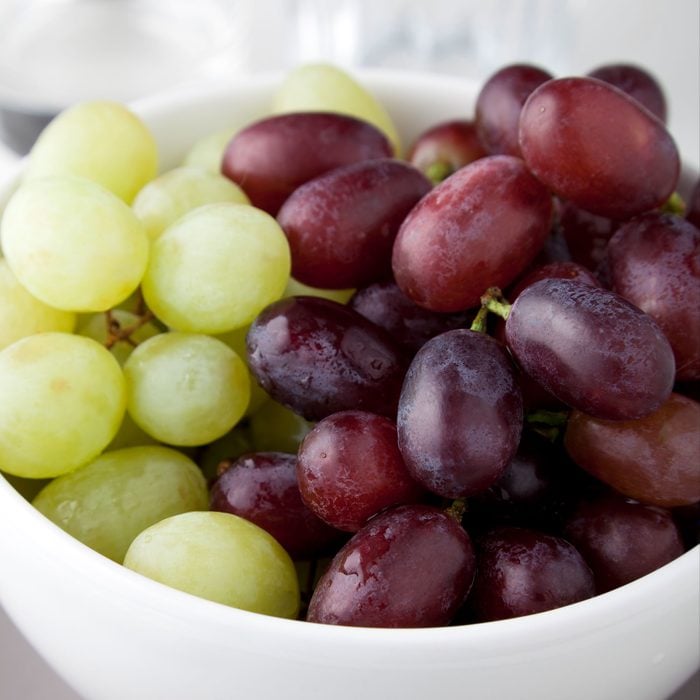Are Grapes Good for People with Diabetes?
Updated: Apr. 12, 2024

Yes; the American Diabetes Association recommends that people with diabetes eat fresh fruit! Here's how to eat grapes and keep blood sugar under control.
People with diabetes don’t have to avoid fresh fruit, even grapes. Here are some ways that grapes can boost your overall health, as well as information that’ll ease any fears you might have about grapes wreaking havoc on your blood sugar.
Just one caveat: Unlike other higher-in-fiber fruits, such as berries, grapes will raise blood sugar, especially if eaten on an empty stomach or without other protein- or fat-containing foods.
Are grapes good for people with diabetes?
Yes; the American Diabetes Association recommends that people with diabetes eat fruit, including green and purple grapes.
Even though carbohydrates can raise blood sugar, the body still needs this macronutrient to make energy. Grapes are an excellent source of carbohydrates for people with diabetes since they have the added benefit of being loaded with beneficial micronutrients such as minerals, vitamins and a variety of disease-fighting phytochemicals.
Since grapes contain natural sugar, they can satisfy a sweet tooth, too. Enjoying this sort of “nature’s candy” may help fend off cravings for other faster-acting sources of sugar, like what’s found in gummies, lollipops and suckers.
Health Benefits of Grapes
Pack in antioxidants
Grapes are an all-around powerhouse when it comes to the wide variety of inflammation and free-radical fighting compounds they contain. Every part—from the skin to the flesh to the seed—is ripe with phytonutrients, including polyphenols such as phenolic acids, stilbenes and flavonoids. These antioxidants protect the brain, heart and liver from damaging toxins and reduce the risk of various cancers, including breast and skin.
Control blood pressure
Resveratrol, a polyphenol found in red grapes, has been shown in clinical trials to help lower blood pressure in people with hypertension. While researchers have focused mainly on using high doses of this plant compound in supplement form and more studies need to be done, the results do make you feel confident tossing a few grapes atop yogurt or a salad!
Lower blood sugar
In one study, people with type 2 diabetes were given a little more than a 1/2 cup of grape-based wine (both with and without alcohol) to drink daily for four weeks. The subjects in both groups had lower fasting blood glucose, lower insulin levels and lower Ha1C, a three-month average of your blood sugar.
While more research needs to be done, the results suggest the possibility that compounds in red wine may improve blood sugar control in people with diabetes.
Reduce cholesterol
In a small but powerful randomized control study, researchers gave dialysis patients and healthy people concentrated red grape juice to drink daily for two weeks.
Following the study, both groups saw significant decreases in their LDL (or “bad”) cholesterol, increases in HDL (or “good”) cholesterol and a decrease in the inflammation linked to heart disease. Researchers suspect that credit for the heart-protecting effects goes to grapes’ impressive combination of carotenoids and vitamin C and E.
How many grapes can people with diabetes have?
That depends! If you’re counting exchanges, it helps to know that 17 grapes contain 15 grams of carbohydrates (or the equivalent of one exchange). If you’re being mindful of the total carbohydrates you eat, it’s useful to know that one cup of grapes contains about 27 grams of carbohydrates.
They’re especially easy on blood sugar when paired with high-fat or high-protein, low-carbohydrate foods. Eat a handful of grapes with a wedge of cheese to create a satisfying snack, slice and toss them with a fresh salad or add a surprising bit of sweetness to chicken salad.
What color grapes are best for people with diabetes?
It depends on what’s important to you. In most grapes, vitamins, minerals and fiber are roughly the same. If you’re concerned about carbohydrates, green grapes are the best choice since they contain slightly less sugar per gram.
If antioxidants and overall disease prevention are important, darker grapes such as red and concord grapes are your best bet because they contain the highest amount of polyphenols.
And if taste is the thing that’ll get you to enjoy grapes more often, then learn how to find just the right sweet-to-sour ratio by reading more about the different varieties of grapes.




















